July 01, 2021 at 03:30AMTime
It’s nearly noon when Pinky Macwan wakes up and rubs her eyes, shifting uncomfortably. She’s in her second trimester of pregnancy with twins and finds herself constantly sluggish. Still in her floral nightgown, she walks down the fluorescent-lit hallway and splashes cold water on her face in the bathroom she shares with 46 other women, all surrogates at various stages of pregnancy. It’s late February, and Macwan has spent the past four months living in the basement of the Akanksha Hospital in bustling Anand, a town in the western Indian state of Gujarat. Home to the headquarters of the major dairy cooperative Amul, Anand has long been known as the milk capital of India. But booming business at Akanksha has also garnered the town another label: India’s baby factory.
[time-brightcove not-tgx=”true”]
A few months earlier, Macwan, 24, was earning $94 a month as a supervisor in a garment factory, overseeing 50 tailors making women’s clothes. The daughter of an iron-factory laborer, Macwan was a bright child and was sent to boarding school, but left at the age of 16 to support her family during hard times. She was married off at the age of 20 to a security guard from a nearby village, but in 2019, sick of feeling “more like a servant” than a wife, she walked away. Things began to look up when she started to work at the garment factory, but when a tough national lockdown was imposed in March 2020 as the first wave of COVID-19 hit India, Macwan and most of her co-workers were fired. She had no savings and struggled to put food on the table, often relying on support from charitable organizations. Worried about caring for her 3-year-old child, she began to look into surrogacy. “If things continue in this vein, then my son’s future is also going to be like mine,” says Macwan, her soft voice shaking. “I thought, If I go once, then I will be able to stand on my own feet.”
In October, Macwan arrived at the Akanksha Hospital, one of the biggest surrogacy facilities in the country. Her mother—who had been a surrogate herself 10 years earlier—had tried to dissuade her. But Macwan argued that the money was much more than she would ordinarily be able to make. Surrogates at Akanksha are paid in installments during the process for a total of about $6,230 for a successful surrogacy for a single baby; in the event of a miscarriage, a woman receives what she has been paid up to that point as well an additional $135. Because she is having twins, Macwan will make $7,395 in addition to the $245 she earned for egg donation. With her living costs taken care of by the hospital, she is able to save most of that money.
Read More: How the Pandemic Is Reshaping India
Macwan is one of thousands of women in India who have chosen to become a surrogate since 2002, when the country legalized the practice, in which a woman carries and delivers a child on someone else’s behalf and is financially compensated for it. (In some cases, surrogacy uses the eggs and sperm of the prospective parents, but if there are health or quality issues, donor eggs or the surrogate’s eggs are used.) Though official numbers are hard to come by, a U.N.-backed study in 2012 by the Delhi-based Sama Resource Group for Women and Health estimated India’s surrogacy business was worth more than $400 million a year, with some 3,000 fertility clinics across the nation.
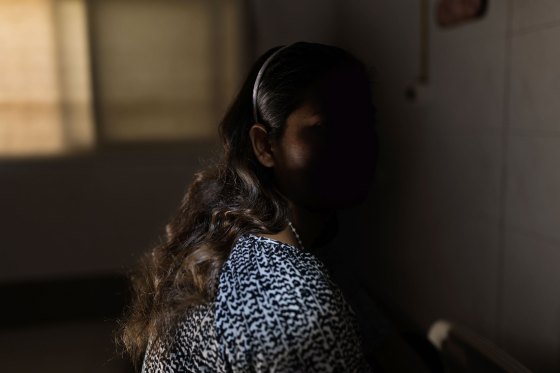
Macwan, like the majority of those making up India’s workforce, was employed in the informal sector, which was particularly badly hit by the pandemic. Many of the women at Akanksha previously worked as domestic help or manual laborers or at small manufacturing units. The amount of money they can make from surrogacy can be life-changing: it could help them secure their family’s future, start a business, educate their children, pay medical expenses or build a solid home. Macwan hopes to use the money to start a small clothing business selling her own brand. While the majority of surrogates are poorer women from rural areas, many educated women have also come to the Akanksha Hospital amid a startling loss of jobs across India during the pandemic to act as egg donors or surrogates.
They might be among the last women in India to be paid for surrogacy. For many years, the country has been one of the few places—including Russia, Ukraine and some U.S. states—where commercial surrogacy is legal. But the ethics of the practice have been under scrutiny for some time, and now a ban on all commercial surrogacy is on the horizon. The ban is part of a new bill that, if enacted, would also prevent LGBTQ couples and single women from accessing surrogacy. Activists have criticized these new restrictions, saying they’re part of Prime Minister Narendra Modi’s conservative agenda to legally define “family” in traditional terms. And while lawmakers argue that the industry exploits impoverished women, experts fear that the ban would cut off one of their few paths out of poverty—especially as COVID-19 continues to batter India’s economy—and push the market underground.
That could leave these women more vulnerable than ever. “If they stop commercial surrogacy, it is not good for poor people like me,” says Savita Vasava, a 34-year-old mother of three from Dakor, a small town 21 miles from the Akanksha Hospital. She is about to be a surrogate for the second time in order to save up for her daughter’s wedding. She’s currently waiting to hear if the embryos recently transferred into her uterus have resulted in a pregnancy. “It is one way for us to make a better life. If we work day and night, we cannot save this kind of money.”
It’s hard to miss the Akanksha Hospital, a shiny edifice of glass and steel that towers over the banana field across from it. As you enter, a screen plays a video on loop showing its charismatic founder, Dr. Nayana Patel, talking about reproductive health. Since 2003, her practice has put Anand on the map as a hub for commercial surrogacy in India. The new hospital building, inaugurated in 2015, is a one-stop shop for fertility, offering egg extraction, in vitro fertilization (IVF), embryo transfer, prenatal care, delivery of children and neonatal care. In the reception area is a photo of Oprah Winfrey, whose endorsement in 2007 led to the clinic’s attracting a large foreign clientele. A floor-to-ceiling collage of press clippings touts the hospital’s success, and pictures of smiling babies—many of them white—adorn the walls. A maze of rooms in the basement of the building houses surrogates for the duration of their pregnancy.

Since its legalization nearly two decades ago, commercial surrogacy has thrived in India, driven by a lack of bureaucratic red tape, a supply of skilled English-speaking doctors, low labor costs and a push to promote medical tourism. At its peak, the industry attracted hundreds of clients a year from wealthy countries, especially the U.S., Australia and Israel, according to Amit Karkhanis, a Mumbai-based lawyer who specializes in contracts between surrogates and intended parents. The Akanksha Hospital, India’s most famous clinic, has been praised in international media for its research and innovation. But how the process works and how surrogates are treated and compensated varies widely from clinic to clinic.
At Akanksha, some women directly approach the clinic, but Patel also has a network of about 20 “caretakers,” women in different areas of Gujarat who help find potential surrogates. After becoming a surrogate herself for the first time in 2019, Vasava has since joined the caretaker ranks. Married off at 16, Vasava eventually divorced her husband and moved back to her mother’s home with her three children. While cleaning a woman’s home in a town nearby, Vasava spoke of her plight and her employer showed her a video of Patel on YouTube. She soon signed up to be a surrogate at Akanksha. “Sometimes we slept with an empty stomach,” Vasava says of her life before she went to the clinic. She used the money from her surrogacy to build a small store, which stocks milk, chips, chocolate, lentils and rice. “After the surrogacy, there is at least always something to eat.”
Vasava still has a picture on her cell phone of the infant she delivered and looks at it every day. “He would be 2 years old now,” she says, recalling her sadness when she handed him over to his intended parents after her cesarean section. Akanksha staff encouraged her to recommend surrogacy to other women she knew, and promised her a fee of $269 for every woman who becomes pregnant at the clinic.
Most clinics in India use agents (who coordinate everything from finding potential surrogates to arranging their housing and medical checkups) or middlemen (sometimes employed by agents to just find the surrogates). However, the methods used by middlemen and agents can vary greatly, as can the fees they charge facilities and the amount they pay surrogates. “There is [no] regulation of agencies or even clinics right now; there are only guidelines,” says Karkhanis, the lawyer. “All these agents do whatever they want to do in their own manner.”
Patel is careful to distinguish the fees she pays to the women who recruit surrogates for her from those paid to middlemen. She prefers to call the fee a “caretaker charge,” saying that the women she hires are not only responsible for vouching for the surrogate’s character and background, but also to act as a liaison between the hospital and the surrogate until the delivery date, checking in on the surrogate’s family and conveying messages from doctors. “She’s the bridge. You can’t rely on anyone who walks in and says, ‘I want to be a surrogate.’ We don’t have any background checks,” says Patel, who created the system in 2007 after having a bad experience with several surrogates.
When Vasava is working for Akanksha, she approaches women in her neighborhood and tells them about the opportunity and her own experience being a surrogate. She has made $538 through this system so far and will be paid $269 more for a third referral who has just become pregnant. “Earlier they were thinking it is a kind of prostitution, but I explained it to them,” says Vasava. “I told them that they should go there for the future of their children. I have gone there myself, and it is very good.”
Her neighborhood is mostly home to people on the lowest rung of India’s caste system, many of whom belong to the Vasava community. (The women in this story and the accompanying photos who share the Vasava surname are not related.) They subsist on daily wagework at construction sites or cleaning homes and live in shanties that flood with every monsoon. Six women from the neighborhood have signed up to be surrogates, and some have built solid concrete homes with the money they earned.
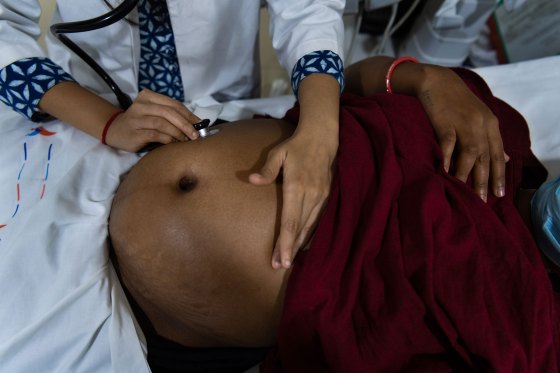
Despite the opportunities that commercial surrogacy offers some women, the industry has been embroiled in controversy for years. Since 2012, news reports of women confined to hostels, paid insufficiently and not given adequate information about the health risks of procedures carried out on them have highlighted the need for reforms, particularly as India became a top destination for foreigners looking for surrogates.
In 2013, concerned about the lack of binding legal standards for how surrogates were being treated, Dr. Ranjana Kumari, the director of the Centre for Social Research, a nonprofit organization based in New Delhi, set out to study the field in order to push for reforms. She visited clinics across the country, including in Anand, and found the treatment of surrogates was highly inconsistent, and in some cases, the women had no rights at all. A 2014 report from her organization highlighted several issues: surrogates rarely received a copy of the contract they signed with the intended parents; most contracts failed to protect the health of the surrogate; and some surrogates underwent up to two dozen IVF sessions. (There is little data on exactly how many IVF cycles are safe over the course of a few years, but each round poses some health risks.) The study also found a huge range in compensation between clinics, and there was often a discrepancy between the amount clinics claimed to be paying and what surrogates said they were receiving. Some women interviewed for the study said that clinic staff were rude to them and “treated them like objects.”
More from TIME
Outsourcing Surrogacy (2015 Documentary)
Things came to a head in 2014, when an Australian couple was found to have abandoned one of their twin babies born to an Indian surrogate. The following year, the Indian Parliament passed new restrictions on surrogacy, making it available only to Indian citizens and putting an end to foreign couples coming to India to find surrogates. Surrogates gathered outside the Akanksha Hospital in protest.
“I’ve seen the industry grow. I’ve seen it come down,” Karkhanis says. In the industry’s boom years, he facilitated nearly 200 agreements each year, meeting 15 new foreign clients each week. These days, he does about 20 agreements annually.
Still, surrogacy has continued to flourish, especially among upper-class, educated Indian women who are looking to have children later in life. Bollywood celebrities like Shah Rukh Khan speaking out about using surrogacy has led to greater acceptance within urban India, but a stigma remains, for both intended parents and surrogates. Macwan told her relatives and neighbors that she was going away for work because she worried that being pregnant while divorced could subject her to malicious rumors. “If I tell anyone, they think that I am going to give away my own child,” she says. “They don’t understand that I am simply giving my womb on rent.”
Prime Minister Modi’s right-wing government doesn’t see it that way and has pushed for further restrictions, telling the Supreme Court in a 2015 affidavit that it did not support commercial surrogacy. In 2019, the government revived a 2016 bill banning commercial surrogacy that had been languishing in the lower house of Parliament. The only surrogacy option would be for what is known as “altruistic surrogacy”—where the only compensation is for medical expenses and insurance—and that would be limited to childless Indian heterosexual couples who had been married for at least five years, had a doctor’s certificate proving their infertility, and were in the age groups of 23 to 50 for women and 26 to 55 for men. Under this proposal, only a close relative between the ages of 25 and 35 could act as a surrogate.
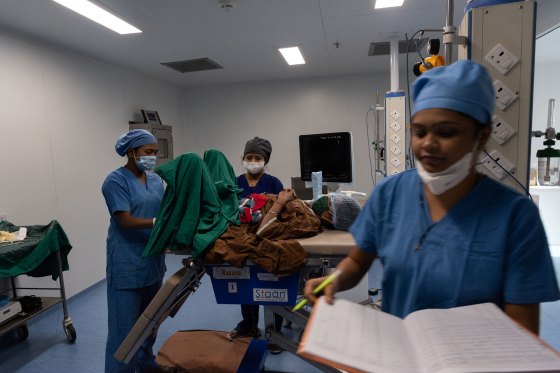
Passed by the lower house in August 2019, the Surrogacy (Regulation) Bill was broadly criticized as too restrictive and failed to clear the upper house. A committee of 23 members of Parliament was directed to examine the surrogacy industry and recommend amendments to the legislation. In the course of their research, committee members met with Patel and Karkhanis, both of whom voiced opposition to several clauses of the bill. The committee ultimately recommended allowing any “willing woman” and not just a “close relative” to be a surrogate, removing the five-year waiting period, waiving the requirement for an infertility certificate, allowing widows and divorced women to avail themselves of surrogacy services, and extending insurance coverage for surrogates from 16 months to 36. In February 2020, the union Cabinet—the government’s most senior ministers—approved these recommendations, which will likely be passed by the upper house of Parliament this year and become national law.
Still, the bill would ban anything except altruistic surrogacy, with the Modi government insisting that the commercial surrogacy business takes advantage of low-income women. “While many couples benefited from surrogacy facilities in India, the practice has persisted without any legal framework,” Bhupender Yadav, a member of Parliament who chaired the select committee, wrote in a February 2020 Hindustan Times column. “Under these circumstances, there have been many reported incidents of unethical practices surrounding surrogacy. These practices include the exploitation of surrogates, abandonment of children born out of surrogacy, and the import of human embryos and gametes.” The new legislation, he argued, would protect surrogates from exploitation and protect the rights of children born through surrogacy.
Women’s-rights advocates agree that the industry needs more regulation. The issue with the proposed law, they say, is that it fails to address the main problems with current practices and does not take into account the interests or voices of surrogates. They are primarily concerned with the mandate that makes only “altruistic” surrogacy legal, arguing that it will lead to women being pressured into becoming surrogates against their will. “We believe very strongly that altruism in a patriarchal society like ours could lead to coercion,” says Sarojini N, founder of Sama, the Delhi-based group working on women’s health issues. Not remunerating a woman for reproductive labor is not enough to prevent exploitation, she argues.
In the recommendations she submitted to the government in 2014, Kumari had pushed for legal protection for the surrogates and intended parents, guaranteed medical insurance for the surrogates and a minimum amount of compensation. “We never wanted the ban, but we wanted the total protection of the women who are offering the womb for a child,” she says. “Banning never works. It hasn’t worked for drugs or alcohol. How will it work for something which is so human?”
Usha Vijay Parmar’s experience is a common one in India, where uneducated women with few other employment opportunities sign up to be surrogates, live away from home for the duration of their pregnancy and agree to medical procedures without a full understanding of their health risks. Parmar’s husband died three years ago from liver failure brought about by alcoholism. Since then, she has struggled to keep up with the expenses of taking care of her mother-in-law and two children; the $161 she makes each month through farming and raising cattle is spent on household expenses, leaving her with little savings. When her aunt—who had previously been a surrogate at Akanksha—suggested she do the same, Parmar didn’t understand what that meant. Her aunt told her that it was similar to how they insert sperm in buffaloes, a process Parmar was familiar with.
Parmar visited the hospital two years ago with her aunt and submitted her application to be a surrogate, along with her national identity card, birth certificate, her husband’s death certificate and passport-size photographs of her whole family that she had to have specially taken. Prospective parents often tell the clinic that they would like to choose a surrogate on the basis of religion, diet, skin color and age.
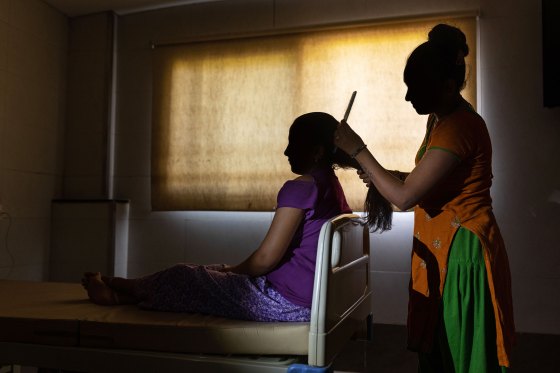
On Feb. 29, 2020, she delivered a child through a C-section. She was 33 at the time and says she chose the surgery because it took less time than a vaginal delivery, and she believed it might be safer for a woman of her age. “There are some surrogates here who have a normal delivery, but it is rare,” Parmar says. “Some surrogates insist on it; then the hospital does it.” She met the intended parents for the first time the day she gave birth, and appreciated that they took a picture while she held the baby girl. Fifteen days later, she went home. “I am giving a couple that cannot have the opportunity to have a baby a child, and in return, they are giving me money that can help my children,” she says. “This is not a business. It is a service.”
But while Parmar may describe it as a reasonable exchange, experts like Sital Kalantry, a clinical professor of law at Cornell Law School who has written extensively about surrogacy, worry about the lack of informed consent often involved in commercial surrogacy, especially given that many of the women are unable to read the contracts written in English, and sign them using their thumbprint. She says there is a conflict of interest created by the doctor acting as both the fertility doctor and the surrogate’s ob-gyn, which she believes means that the health of the fetus is often prioritized over the health of the surrogate. Like Parmar, most surrogates get C-sections, Kalantry explains. “Those are more invasive than a vaginal birth,” she says. “But it’s probably safer for the fetus, and it’s probably also more convenient for the doctors. It’s more convenient for the intended parents so that they don’t have to wait around.” (Patel says she tries to help surrogates deliver vaginally, but if there is a medical issue or the woman requests it, they do a C-section. She says her clinic has a C-section rate of 70%; the national rate is 17.2%.)
Kalantry also takes issue with the convention of having surrogates stay away from home, though some say they prefer it in order to avoid the prying eyes of neighbors and relatives. “I think putting women in a surrogate home is problematic,” Kalantry says. “It’s almost like a jail-like situation.” While well-established clinics like Akanksha do not require surrogates to spend nine months in the center, they strongly encourage it. Women’s-rights advocates cite the troubling power dynamics of wealthy, urban doctors asking uneducated, rural women to stay in clinics where they can monitor them. Meanwhile, experts say conditions in smaller clinics are considerably worse.
After her first time being a surrogate, Parmar was able to save some money in a fixed deposit. Now, she is back at Akanksha, hoping to earn more money to save for her children’s education and marriage. With schools closed because of the pandemic, she has brought her 10-year-old son Satyam; he sits beside her eating lunch in the room she shares with seven other surrogates. But Parmar’s stay is different from her previous one in other ways too.
The first time, Akanksha offered classes in makeup, sewing and making decorative objects. This time around, pandemic restrictions mean the women have no activities to distract them. Parmar was restless when she first arrived at Akanksha, not allowed to go beyond the hospital complex except for family emergencies. By lunchtime on the day we spoke, she had already washed her clothes and visited the temple on the hospital’s lawn; the rest of her day would be spent chatting with the other surrogates and watching television. Soon, the women would be served coconut water and fruits, a luxury Parmar could not afford back home.
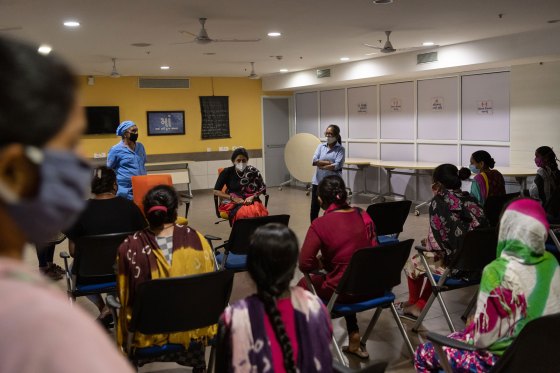
Patel has been at the center of the ethics debate surrounding surrogacy in India. When she is not in scrubs, she can be found in her office wearing a gleaming string of pearls, several diamond rings and a graceful silk sari. People stream in and out, handing her papers to sign and asking her advice on medical procedures. Patel argues that regardless of what you think of the moral debate, the altruistic approach is simply impractical. “Of course it should be a willing woman. You should not force anyone; the surrogate has to voluntarily understand the procedure,” she says. “But if she comes, stays for nine months, gives the baby and in return is not compensated in any way, how will it work? Why would anyone do this for free?”
If she’s right and the number of surrogates plummets, that would leave few options for women like Navpreet Gambhir, who has been trying to start a family for 12 years. In November, with the pandemic still raging, she and her husband drove 700 miles from her home in Dehradun, a small city in the northern state of Uttarakhand, to Anand. “I had almost lost hope in being able to have a child,” says Gambhir, recalling how she cried when she first met the young woman who would be her surrogate. “She said, ‘Don’t worry, I will do this for you.’ I was so touched.”
Read More: India’s COVID-19 Crisis Is Spiraling Out of Control. It Didn’t Have to Be This Way
Gambhir, 34, who runs a small catering business from her home, was married in 2009 and began planning for a child soon after. But she is a lupus patient, which made her journey to motherhood complicated. Pregnancy for women with lupus, a chronic autoimmune disease, can be very risky if the disease is not under control, and may lead to flare-ups of the condition, miscarriage or stillbirth. After trying unsuccessfully for many years to get pregnant, she finally conceived in 2016, only to have a miscarriage. She thought about adoption, but the process is extremely complicated in India, with prospective parents often waiting several years to be matched with a child.
When she and her husband began considering surrogacy, their family voiced concerns, Gambhir says. They had heard rumors of surrogates asking for more money than was agreed upon, blackmailing the family and even terminating the pregnancy. Gambhir and her husband visited a fertility clinic in New Delhi, closer to their hometown, but were troubled by the clinic’s plan to put them in touch with a middleman, who would find a surrogate and bring them to the clinic. The clinic would not have the surrogate’s medical history and would not require the surrogate to live at the clinic during the pregnancy.
“It was very important to us that the surrogate lives at the hospital,” Gambhir says. “We would be worried about how she is staying, her nutrition. Also, she can say, ‘Sorry, ma’am, I’ve aborted the child.’” They eventually decided to go ahead with surrogacy at Akanksha, impressed with how the hospital was run. The procedure was costly—$2,689 for the egg retrieval, and an additional $18,823 for the surrogacy—and the Gambhirs had to dip into their savings to pay for it. The surrogate did not become pregnant on the first try, but they were back three months later, hoping for a better outcome.
“To people who say that this is a baby factory, they should see the couples who are suffering, unable to have a child,” Gambhir says. “If they want their own genetic baby, what will they do?”
As India struggles to recover from a brutal second wave of the COVID-19 pandemic, the amended surrogacy bill that awaits consideration by the upper house of Parliament has been put on the back burner. But the new restrictions have already become a flash point in a broader culture war under way in India around the rights of women and LGBTQ people. Activists point out that the surrogacy bill limits access to those currently or formerly in heterosexual marriages, while other legislation in India has recognized the rights of live-in couples, single people and LGBTQ people. “If the legislation passes in its current form, it will be challenged before the Supreme Court,” says Aneesh V. Pillai, an assistant professor of law at Cochin University who completed his Ph.D. research on the legal framework of surrogacy in India. He believes the Supreme Court will object to the law because it violates the constitutionally guaranteed right to equality—though the court has, in recent years, rarely ruled against the central government.
Read More: This Same-Sex Couple Is Fighting for the Right to Marry. But Is India Ready?
Same-sex sexual relations were decriminalized in 2018, but the government continues to oppose same-sex marriage, telling the high court in February that the “Indian family unit concept … necessarily presuppose[s] a biological man as ‘husband,’ a biological woman as ‘wife’ and children born out of union.” As recently as 2016, India’s Minister of External Affairs Sushma Swaraj declared that allowing gay people to have a surrogate child “doesn’t go with our ethos.”
“The Indian constitution talks about equality, but this legislation does not even consider that,” says Sarojini N, the Delhi-based activist. “Social morality has been put at the center. It is definitely discriminatory toward LGBT people and people not in the institution of marriage.” While single women would still be allowed to adopt in India under other legislation, she notes, they would not be allowed access to surrogacy unless they are widowed or divorced.
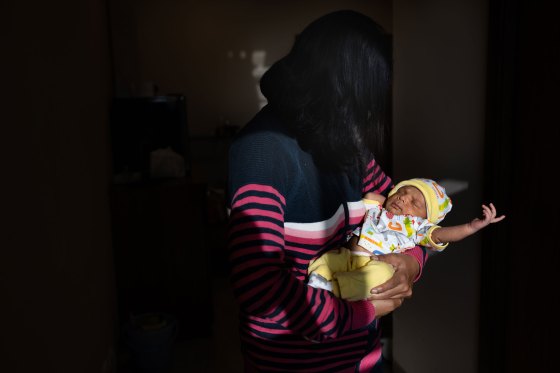
If the ban goes ahead and is upheld by the court, experts are concerned it will create an underground economy with worse conditions, where paid surrogacy would continue unregulated.
This would leave the surrogates with no protections at all and unable to demand safeguards. Clinics and intended parents could circumvent the law by using cash transactions or inflating the costs of medical expenses or insurance on paper to conceal compensation for a surrogate. And while established clinics in larger cities might stay away from surrogacy under these circumstances—Patel says she would opt to close her hospital’s surrogate ward to avoid being a party to any transactions that were not aboveboard—more rural clinics might continue to operate unregulated. That’s how things have played out in other countries. Despite commercial surrogacy being banned in China, the New York Times estimated that more than 10,000 children a year are born there through that process.
If all goes well for Macwan, whether or not commercial surrogacy is banned will not directly affect her. Many of the women she has met at Akanksha have been surrogates before, but she hopes she will never be in such dire need again. She misses her son, who lived with her at the hospital until discomfort from the pregnancy made it difficult for her to look after him. She speaks to him by phone every day, but finds it hard to carry him when he visits because she recently had to get cervical stitches to ensure that she does not deliver prematurely. She wishes she could leave the hospital premises but is worried about health complications that might occur while away.
Last year, she got engaged to Vivek, a young man who worked alongside her at the garment factory. She is glad he is open-minded and was supportive of her decision to become a surrogate. They plan to get married after she delivers the twins but do not want more children of their own. Yet she does not regret her decision to be a surrogate.
“Someone is not able to have a child, I am able to get pregnant, I am giving them a child,” she says. “They have a need. We also have a need. So what is wrong with this work?”
—With reporting by Madeline Roache/London







